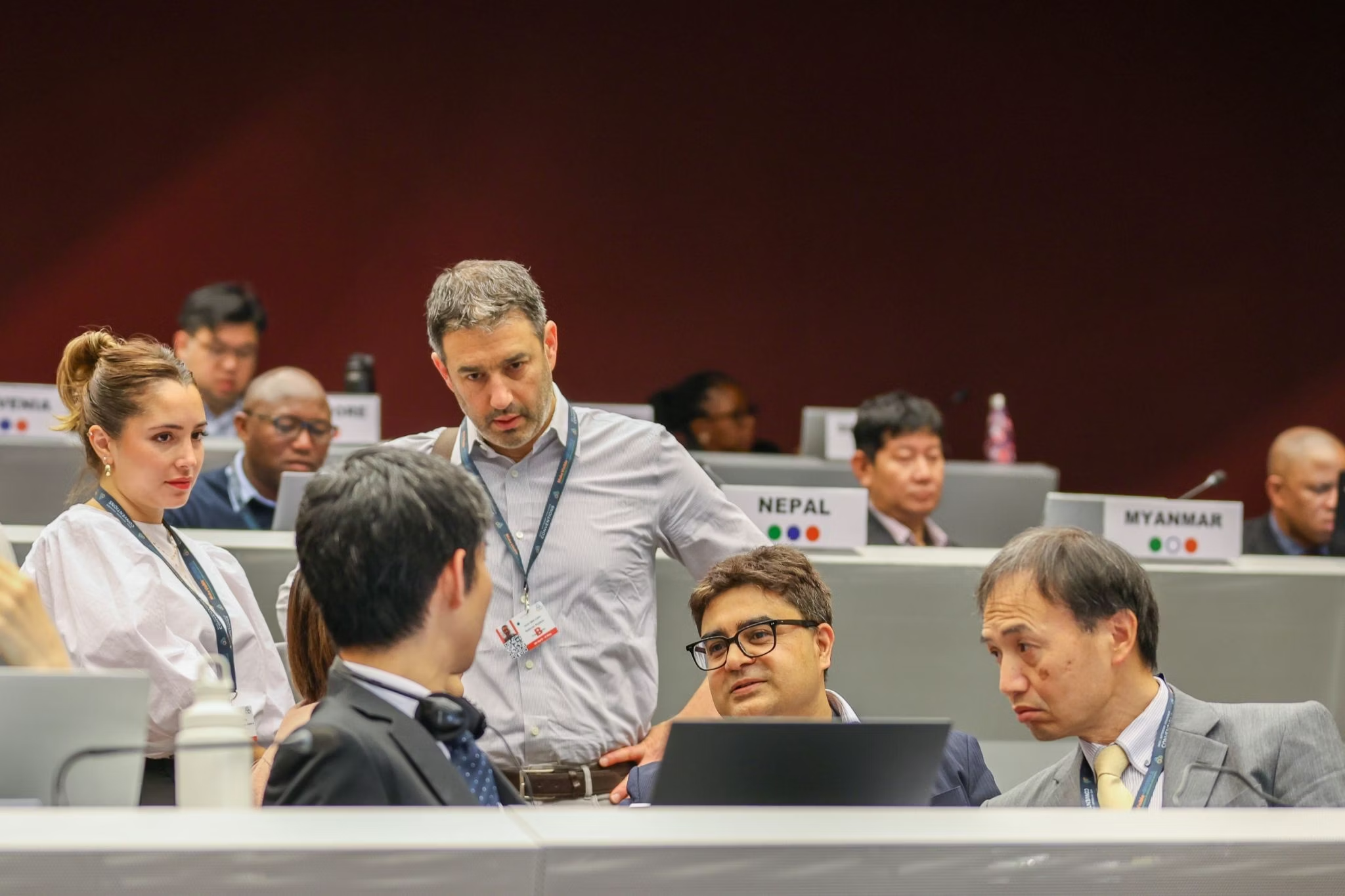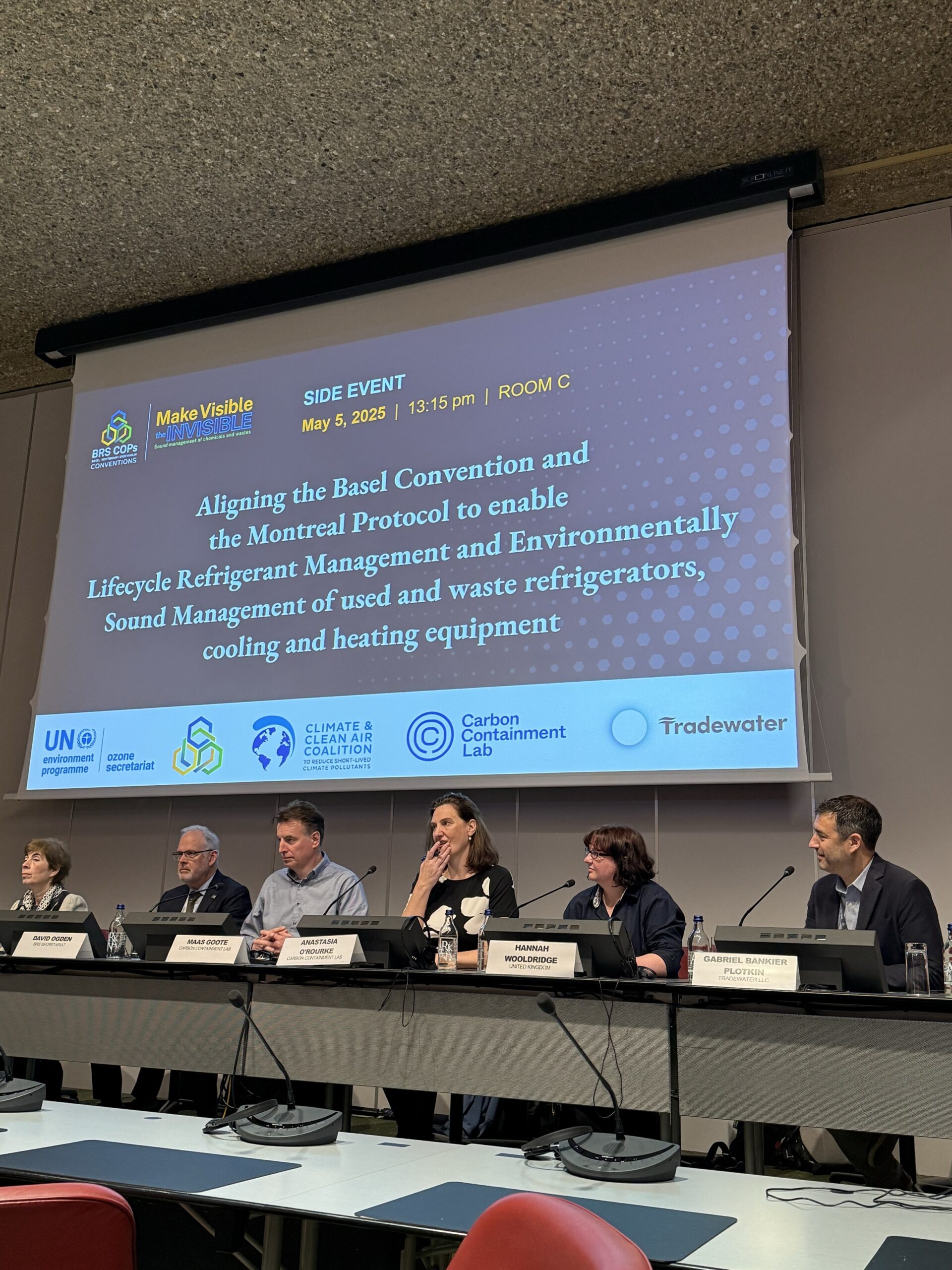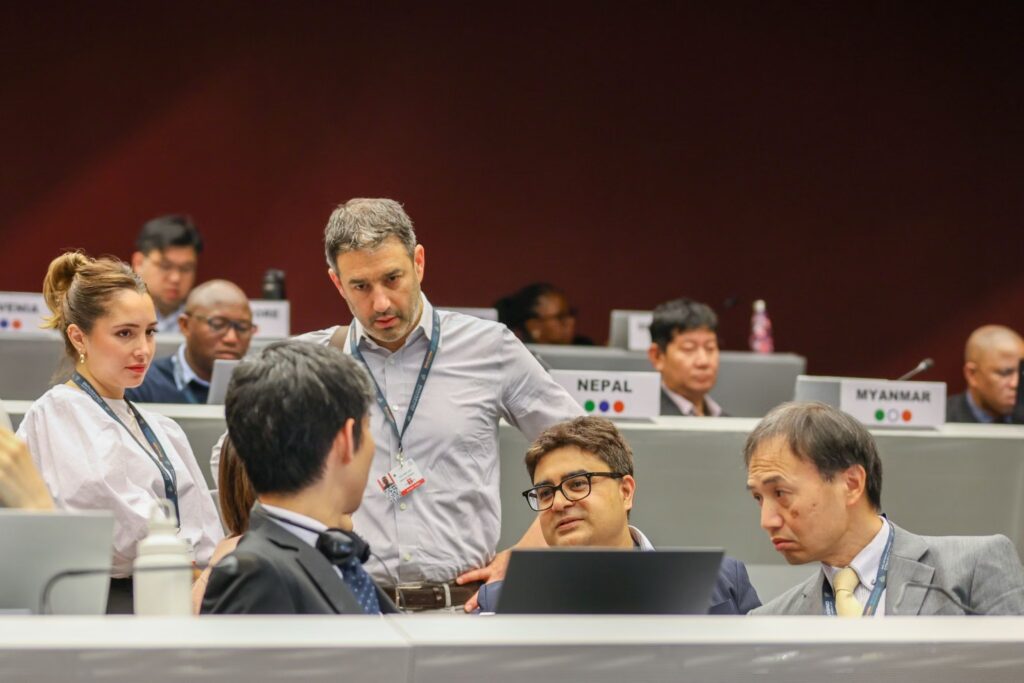Behind the Scenes at the 2025 Basel Convention COP
- June 2, 2025

Introduction to Basel Convention COP
Tradewater’s quest to permanently prevent as many non-CO2 greenhouse gases (GHG) as possible from reaching the atmosphere is a global one. GHG emissions from refrigerants or methane harm the planet equally, whether they leak from the United States, Chile, Thailand, or Ghana. Tradewater’s strategy is to find recovered and unused refrigerants around the world, collect them, and then safely and effectively destroy them.
Our work fills a glaring hole in the famous Montreal Protocol, an international agreement signed in 1987 that banned future production of ozone-depleting substances (ODS), which include the refrigerants often found in refrigerators and air conditioning units, or the halons in fire extinguishers. While ODS can be many thousands of times more potent than CO2, there was no plan to eliminate the billions of tons of CO2 equivalent of ODS already produced and in use, once that material reached the end of its useful life. Swiftly and permanently preventing these gases from reaching the atmosphere is critical to avoid unnecessary planetary warming.
Tradewater projects often discover material in one country but must send it to another hemisphere for destruction. As of May 2025, Tradewater only works with three facilities in countries that both permit the import of hazardous waste for destruction via incineration (Tradewater’s preferred method) and that meet the Montreal Protocol’s destruction and removal efficiency requirements and emissions limits.
The trip from discovery to destruction is rarely as simple as moving it from Point A to Point B. Sometimes routes include more than ten different countries the material must pass through. Transporting material from the point of origin to its destination requires us to navigate the complicated maze of the Basel Convention on the Control of Transboundary Movements of Hazardous Wastes and their Disposal (Basel Convention).
The general goal of the Basel Convention is to prevent wealthy countries from sending their hazardous waste to developing countries – using these countries with fewer resources as a dumping ground. Counterintuitively, especially as it relates to Tradewater’s ODS projects, the current framework traps these wastes in developing countries and prevents them from moving to a place where they can be safely and effectively destroyed. And that’s why Tradewater’s co-founder, Gabe Plotkin, and Logistics Associate, Ana Fernandez, traveled to Geneva in early May to attend this year’s Conference of the Parties (COP) to the Basel Convention.
Basically, every two years, all the countries who are signatories to the Basel Convention meet to improve the import, export, and handling of hazardous materials – such as the refrigerant gases Tradewater destroys (via projects that turn into carbon offset credits) – to minimize harm to human health and the environment.
Tradewater was the only carbon offset project developer to this year’s COP. We specifically wanted to better understand and work with parties to improve the process in each country. The detailed Prior Informed Consent procedure includes strict requirements for transboundary movements of hazardous wastes and other wastes. Those rules haven’t been updated in 30 years, since the treaty was originally signed! With 191 current signatories to the Basel Convention, things can get complicated.
We spoke with Gabe and Ana to hear why Tradewater attended the conference, what our company was hoping to achieve, and what to expect in the months ahead.
Q&A with Gabe & Ana
Daniel: Before getting into the conference details, Gabe, can you please explain why Tradewater’s refrigerants are considered a hazardous waste under the Basel Convention?
Gabe: The Basel Convention governs the movement of hazardous waste, and refrigerants are deemed to be hazardous because of their harmful impact to the planet. They’re not hazardous because of their immediate impact on humans – they’re not toxic to humans, they’re not flammable, and they’re not corrosive. They are, however, toxic to the atmosphere. Under the Basel Convention, the term used is ‘ecotoxic,’ because they harm the ozone layer.
And while it is up to countries to define what waste is, in general, most countries will tell you that if you decide to destroy this gas at the end of its useful life, it becomes a waste. More specifically, it is a hazardous waste that then needs to be governed by the Basel Convention.
Daniel: OK, now over to Ana. How does the designation of refrigerants as hazardous waste impact Tradewater?
Ana: It creates a significant logistical challenge for us. Because a key element of the Basel Convention requires Prior Informed Consent – basically, the permission – of every country where our refrigerant touches on its shipment route, from origin to the place we destroy it, we need to work through a very complicated process.
And a key challenge for Tradewater is that each country has different rules, different documents, and different processes for giving companies like Tradewater consent to ship this material to, from, and through their borders.
It’s not one body deciding how to move material from Point A to Point B. You have the country that is exporting the material, plus the importing country, plus the countries along the transit route that we need to ship the material through. It becomes a long, complicated process to receive all of the permits we need to ship the material for destruction.
Smoothing out these variations is where Prior Informed Consent procedures could improve.
Daniel: That sounds like a super complicated process. How many countries are typically involved in one of Tradewater’s shipments?
Ana: It depends! Let’s say you have material in Singapore and you want to destroy it in France. You might have as many as 10 transit countries in the middle! Some transit countries might need physical paper to process the materials. Each country is a completely different world, making it hard to navigate the best freight route. There’s no standard procedure for obtaining consent.
Gabe: And nothing gets on a boat until you go through all of these processes for every single transit country. You have to have the full set of permissions and paperwork buttoned up before it gets on the first boat. In one instance, it took 20 months to finalize all the paperwork for one of our shipments, and then the actual transportation of the material took another two to three months. It should not take nearly two years to destroy potent greenhouse gases that are threatening to warm our planet.
Daniel: Wow, that must mean a lot of paperwork! And that brings us to Basel COP itself where Tradewater joined the conversation around transporting hazardous waste. Why is this conference so important for the broader climate?
Gabe: We wanted to help the Basel focal points – the people who spend all of their time focused on the movement of hazardous waste – understand that the role that they play impacts the fight against climate change. A lot of the waste that Basel focal points normally deal with do not impact climate change. Think about PCBs, as an example. These are hazardous because they get into groundwater and land and can directly affect human health. [According to the EPA, PCBs belong to a broad family of man-made organic chemicals known as chlorinated hydrocarbons. PCBs were domestically manufactured from 1929 until manufacturing was banned in 1979.]
Remember, the Basel Convention supposedly exists to disincentivize wealthier countries from, essentially, offloading emissions to less wealthy nations. Yet, in our line of work, we typically find material in developing countries and then need to move it to wealthier, European countries; the ones with the best destruction facilities.
So, we really wanted to help the Basel community understand that if they can work with us figure out how to make the Prior Informed Consent process happen more smoothly, they could play a positive role in the fight against climate change.
Daniel: What goals did Tradewater have going into the conference?
Gabe: The Montreal Protocol administrators, who govern the refrigerants we find and destroy, recognize that the people who administer the Basel Convention play a critical role in this work. So, along with the Carbon Containment Lab, Tradewater was there to help bridge the gap between these communities, to talk about refrigerants as waste and the connection between climate and refrigerants.

Daniel: Ana, through your experience helping Tradewater navigate the international logistics scene, what type of credibility has Tradewater built up?
Ana: If the transit country that you’re contacting does not know or understand who you are, they’re not going to answer your questions or concerns. Almost all of them asked why Tradewater is not in all of the documents they receive.
Well, Tradewater is quite unique. The companies involved in a typical shipment of hazardous waste include the generator of the waste, the shipper of the waste, and the facility that is going to treat or destroy the waste. Since Tradewater doesn’t fill these roles, country representatives won’t find our name in the documents they review before granting consent to a particular shipment. This leads to a lot of confusion when I reach out and ask a Basel focal point for permission to move refrigerants through their country.
So, a crucial goal for Tradewater was to show up and introduce ourselves. We wanted to let the Basel Convention community know who we are and what we do, and why they should support our efforts. I had great conversations with numerous country representatives. They said, ‘OK, now I understand what you’re doing and why you’re in the middle of all the parties.’
I was trying to understand their needs, make Tradewater’s name known, and explain what we’re doing. Our ultimate goal is to figure out how we can reduce a potential 20-month waiting period down to two or three months.
Daniel: What is the timeline for measuring Tradewater’s success at Basel COP?
Ana: I think we’re already seeing success from our efforts: Four countries gave us permissions that we were waiting for at Basel COP and two more granted permission in the weeks right after! We spoke to the right people and earned their trust.
Moving forward, success is a continually shorter process each time we wade through global network of Basel signatories. I believe that our presence, as the only carbon offset project developer at COP, gave transit countries the confidence to work with us in the future.
Daniel: Moving forward, what’s next for Tradewater and other Basel Convention stakeholders?
Gabe: We talked to 40 different countries; everyone on our wish list we were able to shake hands with, introduce ourselves, and as Ana said, make sure they know who Tradewater is and that we can be trusted. The personal connection will make it easier to have a stronger voice as it relates to updating the Prior Informed Consent procedure and to get our material moved around the globe faster.
I think there’s a real opportunity to bring together the Basel community and the Montreal Protocol community. They have a real desire to connect and help each other, but they don’t quite know what that means since one group focuses on hazardous waste and the other specializes in ODS. Hopefully Tradewater can play a part in helping facilitate that connection.
From Basel to Montreal
Coming out of this conversation, we couldn’t help but notice the shared commitment of everyone at these conferences. Tradewater has its goals, but any and all destruction of ODS is a win in our book. Our company might facilitate 10 shipments of hazardous refrigerant a year, but these transit countries handle 10,000’s of shipments in that same timeframe.
Connecting the dots and finding common ground makes these conferences stronger and gives the world a better chance at mitigating the worst effects of climate change. Tradewater will be at November’s 37th Meeting of the Parties to the Montreal Protocol on Substances that Deplete the Ozone Layer (MOP) taking place in Kenya as we continue to push for better international cooperation in the pursuit of permanently destroying ODS.
Read our other blogs
What sports and refrigerant gases have in common (and why it’s more than you’d think)
For teams looking to lower their footprint without compromising performance or operations, tackling refrigerants offers…
CFCs and HCFCs – A blind spot in corporate & global GHG accounting
In the corporate world, there is less importance placed on destroying these gases because they…
Behind the Scenes at the 2025 Basel Convention COP
Tradewater was the only carbon offset project developer to this year’s COP. We specifically wanted…





